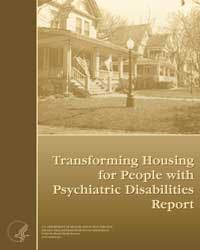Transforming Housing for People
with Psychiatric Disabilities
By Kristin Toburen
 According to a new report from SAMHSA, most board and care homes for people with psychiatric disabilities are currently indistinguishable from institutions, and residents are given very little opportunity for recreation and community involvement. According to a new report from SAMHSA, most board and care homes for people with psychiatric disabilities are currently indistinguishable from institutions, and residents are given very little opportunity for recreation and community involvement.
The publication, Transforming Housing for People with Psychiatric Disabilities Report, calls for improvements to conditions in existing homes and also an across-the-board reduction in reliance on them by many states.
The term “board and care home” describes living arrangements that provide shelter, food, and 24-hour supervision or protective oversight and personal care services to residents. Other terms describing such living arrangements include homes for the aged, residential care homes, adult foster care, and recently, assisted-living facilities.
By the mid-1990s, according to the report, the Federal Government estimated that 1 million people across the Nation lived in board and care homes.
The result of a study inspired by the President’s New Freedom Commission on Mental Health, the report offers 10 detailed recommendations to improve the quality of life of residents of board and care homes (see Recommendations To Improve Board and Care Homes). The recommendations call for a recovery-oriented approach based on the principles of self-direction and community involvement.
For the complete report online, visit SAMHSA’s Web site at http://mentalhealth.samhsa.gov/publications/allpubs/sma06-4173. Print copies are available by calling SAMHSA’s National Mental Health Information Center (NMHIC) at 1 (800) 789-2647 (English and Español) or 1 (866) 889-2647 (TDD). Request publication number (SMA) 06-4173. 
Back to Top
Recommendations To Improve
Board and Care Homes
SAMHSA’s new report on transforming the board and care home system includes the following 10 recommendations:
- Incorporate residents’ needs into state Olmstead* plans and establish reform coalitions. Coalitions
with a variety of members—including residents and legal advocates—should make thorough
reviews and housing recommendations. Residents should be as integrated into the community as
much as possible.
- Increase consumers’ options for self-direction. Residents’ financial
choices and flexibility should be increased. Federal agencies should work with states to foster
consumer-directed services.
- Improve methods of outcome measurement. For residents, health and quality
of life should be monitored and improved.
- Strengthen peer support and community outreach and education. Set aside grants
for peer support and establish peer-run wellness centers in the community that provide access
to health care, education, legal services, and transportation.
- Reaffirm the role of protection and advocacy (P&A) agencies. P&A agencies
should have direct access to the homes, oversee their operation, and educate residents about
their rights.
- Modernize state regulations. A central registry of board and care homes is
recommended to ease housing approval. Also, homes need to include more residents in inspections
and evaluations.
- Expand and clarify the mandate of long-term care ombudsman programs. Ombudsman
programs should pay closer attention to the needs of residents and work more closely with P&A
agencies.
- Enhance access to physical and mental health care. Health care should continue
after residents leave board and care homes, and each resident should have a wellness recovery
action plan.
- Strengthen residents’ rights. State laws should require that residents
have the full rights of tenancy, including a resident bill of rights. In addition, the use of
seclusion and restraint must be prohibited.
- Establish quality improvement measures. State oversight agencies should develop
incentives for best practices. And, homes should provide ongoing education and quality improvement
plans.
Complete descriptions of each recommendation are provided in the report, which is available online at http://mentalhealth.samhsa.
gov/publications/allpubs/sma06-4173. 
Note: * The Supreme Court’s Olmstead decision requires that state and local mental health agencies provide access to housing and other services in the “most integrated setting” appropriate to the needs of people with psychiatric disabilities. |
« Previous Article
Next Article »
Back to Top
|


